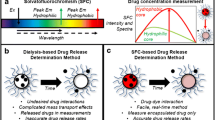Abstract
The objective of this study is to elucidate the combined effects of a novel type of material being investigated as a new excipient, an octenylsuccinate-modified dendrimer-like biopolymer (OS-DLB) and poloxamer (PLX), on the solubility of poorly water-soluble compounds. Phenytoin (PHT), griseofulvin (GSF), ibuprofen (IBU), and loratadine (LOR) were used as model compounds. Phase solubility measurements were conducted to determine the relative proportions of API, OS-DLB, and PLX that result in the most stable dendrimeric complexes. The solubilizing power of OS-DLB increases with increasing hydrophobicity of the solute. In the presence of PLX, the solubilization effect of OS-DLB is modestly accentuated for the most hydrophobic drugs (IBU and LOR) but has no effect on the least hydrophobic one (PHT). The maximum potentiation effect of PLX on the solubilizing properties of OS-DLB was observed for GSF, the drug of intermediate hydrophobicity. Three different types of solubilization profiles were obtained in the study. All three different profiles can be appropriately described by a single solubilization model, depending on the specific parameter values. The defining parameters of the model reflect the hydrophobicity of the drug on the one hand and, on the other hand, the inherent tendency of the drug (crystal lattice energy) toward crystallization.







Similar content being viewed by others
References
Yalkowsky SH. Solubility and solubilization in aqueous media. New York: American Chemical Society; 1999.
Lin X, Hu Y, Liu L, Su L, Li N, Yu J, et al. Physical stability of amorphous solid dispersions: a physicochemical perspective with thermodynamic, kinetic and environmental aspects. Pharm Res. 2018;35(6):125. https://doi.org/10.1007/s11095-018-2408-3.
Shimizu S, Matubayasi N. The origin of cooperative solubilisation by hydrotropes. Phys Chem Chem Phys. 2016;18(36):25621–8. https://doi.org/10.1039/C6CP04823D.
Kim JY, Kim S, Papp M, Park K, Pinal R. Hydrotropic solubilization of poorly water-soluble drugs. J Pharm Sci. 2010;99(9):3953–65. https://doi.org/10.1002/jps.22241.
Kim JY, Kim S, Pinal R, Park K. Hydrotropic polymer micelles as versatile vehicles for delivery of poorly water-soluble drugs. J Control Release. 2011;152(1):13–20. https://doi.org/10.1016/j.jconrel.2011.02.014.
Hoye JA, Myrdal PB. Measurement and correlation of solute solubility in HFA-134a/ethanol systems. Int J Pharm. 2008;362(1):184–8. https://doi.org/10.1016/j.ijpharm.2008.06.020.
He Y, Li P, Yalkowsky SH. Solubilization of fluasterone in cosolvent/cyclodextrin combinations. Int J Pharm. 2003;264(1):25–34. https://doi.org/10.1016/S0378-5173(03)00389-2.
Li P, Tabibi SE, Yalkowsky Samuel H. Solubilization of flavopiridol by pH control combined with cosolvents, surfactants, or complexants. J Pharm Sci. 2000;88(9):945–7. https://doi.org/10.1021/js990097r.
Grohganz H, Priemel PA, Löbmann K, Nielsen LH, Laitinen R, Mullertz A, et al. Refining stability and dissolution rate of amorphous drug formulations. Expert Opinion on Drug Delivery. 2014;11(6):977–89. https://doi.org/10.1517/17425247.2014.911728.
Karagianni A, Kachrimanis K, Nikolakakis I. Co-amorphous solid dispersions for solubility and absorption improvement of drugs: composition, preparation, characterization and formulations for oral delivery. Pharmaceutics. 2018;10(3). https://doi.org/10.3390/pharmaceutics10030098.
Ong HJ, Pinal R. Drug solubilization by means of a surface-modified edible biopolymer enabled by hot melt extrusion. J Pharm Sci. 2018;107(1):402–11. https://doi.org/10.1016/j.xphs.2017.10.022.
Putaux J-L, Buléon A, Borsali R, Chanzy H. Ultrastructural aspects of phytoglycogen from cryo-transmission electron microscopy and quasi-elastic light scattering data. Int J Biol Macromol. 1999;26(2–3):145–50. https://doi.org/10.1016/S0141-8130(99)00076-8.
Mizrahy S, Peer D. Polysaccharides as building blocks for nanotherapeutics. Chem Soc Rev. 2012;41(7):2623–40. https://doi.org/10.1039/c1cs15239d.
Alexandridis P, Nivaggioli T, Hatton TA. Temperature effects on structural properties of Pluronic P104 and F108 PEO-PPO-PEO block copolymer solutions. Langmuir. 1995;11(5):1468–76. https://doi.org/10.1021/la00005a011.
Bodratti AM, Alexandridis P. Formulation of poloxamers for drug delivery. Journal of Functional Biomaterials. 2018;9:11. https://doi.org/10.3390/jfb9010011.
Scheffler SL, Huang L, Bi L, Yao Y. In vitro digestibility and emulsification properties of phytoglycogen octenyl succinate. J Agric Food Chem. 2010;58(8):5140–6. https://doi.org/10.1021/jf904378e.
Connors K, Higuchi T. Phase solubility techniques. Adv Anal Chem Instrum. 1965;4:117–212.
Takacs-Novak K, Urac M, Horvath P, Volgyi G, Anderson BD, Avdeef A. Equilibrium solubility measurement of compounds with low dissolution rate by Higuchi’s facilitated dissolution method. A validation study. Eur J Pharm Sci. 2017;106:133–41. https://doi.org/10.1016/j.ejps.2017.05.064.
Repta AJ. Alteration of apparent solubility through complexation. In: S.H. Yolkowsky, editor. Techniques of solubilization of drugs. New York: Marcell Dekker, Inc.; 1981.
Yalkowsky SH, Roseman TJ. Solubilization of drugs by cosolvents. In: Yalkowsky SH, editor. Techniques of solubilization of drugs. New York: Marcell Dekker, Inc.; 1981. p. Chapter 3.
Berna N, Berna P, Oscarsson S. Cosolvent-induced adsorption and desorption of serum proteins on an amphiphilic mercaptomethylene pyridine-derivatized agarose gel. Arch Biochem Biophys. 1996;330(1):188–92. https://doi.org/10.1006/abbi.1996.0241.
Kirsch LE, Sinn Y-S. The effect of polyvinylpyrrolidine on the stability of taurolidine. Pharm Dev Technol. 1997;2(4):345–56. https://doi.org/10.3109/10837459709022633.
Timasheff SN. Control of protein stability and reactions by weakly interacting cosolvents: the simplicity of the complicated. In: Di Cera E, editor. Advances in protein chemistry. San Diego, California: Academic Press; 1998. p. 355–432.
Shimizu S, Smith DJ. Preferential hydration and the exclusion of cosolvents from protein surfaces. J Chem Phys. 2004;121(2):1148–54. https://doi.org/10.1063/1.1759615.
Attwood D, Elworthy PH, Lawrence MJ. Effect of structural variations of non-ionic surfactants on micellar properties and solubilization: surfactants with semi-polar hydrophobes. J Pharm Pharmacol. 1989;41(9):585–9. https://doi.org/10.1111/j.2042-7158.1989.tb06536.x.
Lawrence MJ, Elworthy PH, Attwood D. The effect of modification on solubilisation and micellar properties of a non-ionic surfactant. J Pharm Pharmacol. 1985;37(S12):2P. https://doi.org/10.1111/j.2042-7158.1985.tb14074.x.
Elworthy PH, Patel MS. Demonstration of maximum solubilization in a polyoxyethylene alkyl ether series of non-ionic surfactants. J Pharm Pharmacol. 1982;34(9):543–6. https://doi.org/10.1111/j.2042-7158.1982.tb04790.x.
Jansook P, Loftsson T. CDs as solubilizers: effects of excipients and competing drugs. Int J Pharm. 2009;379(1):32–40. https://doi.org/10.1016/j.ijpharm.2009.06.005.
Acknowledgments
We thank Prof. Yuan Yao’s laboratory for providing the DLB material used in the study.
Funding
Financial support from the Dane O. Kildsig Center for Pharmaceutical Processing Research (CPPR), Purdue Research Foundation, and the National Science Foundation (NSF DMR 1310475) is gratefully acknowledged.
Author information
Authors and Affiliations
Corresponding author
Additional information
Guest Editors: Philip J. Kuehl and Stephen W. Stein
Publisher’s Note
Springer Nature remains neutral with regard to jurisdictional claims in published maps and institutional affiliations.
Rights and permissions
About this article
Cite this article
Ong, H.J., Pinal, R. Drug Solubilization by Means of Partition/Association Equilibrium Using a Modified Nanosized Dendrimeric Biopolymer. AAPS PharmSciTech 20, 304 (2019). https://doi.org/10.1208/s12249-019-1490-0
Received:
Accepted:
Published:
DOI: https://doi.org/10.1208/s12249-019-1490-0




